YAMAHA YZ450F 2010 Owners Manual
Manufacturer: YAMAHA, Model Year: 2010, Model line: YZ450F, Model: YAMAHA YZ450F 2010Pages: 230, PDF Size: 14.09 MB
Page 181 of 230
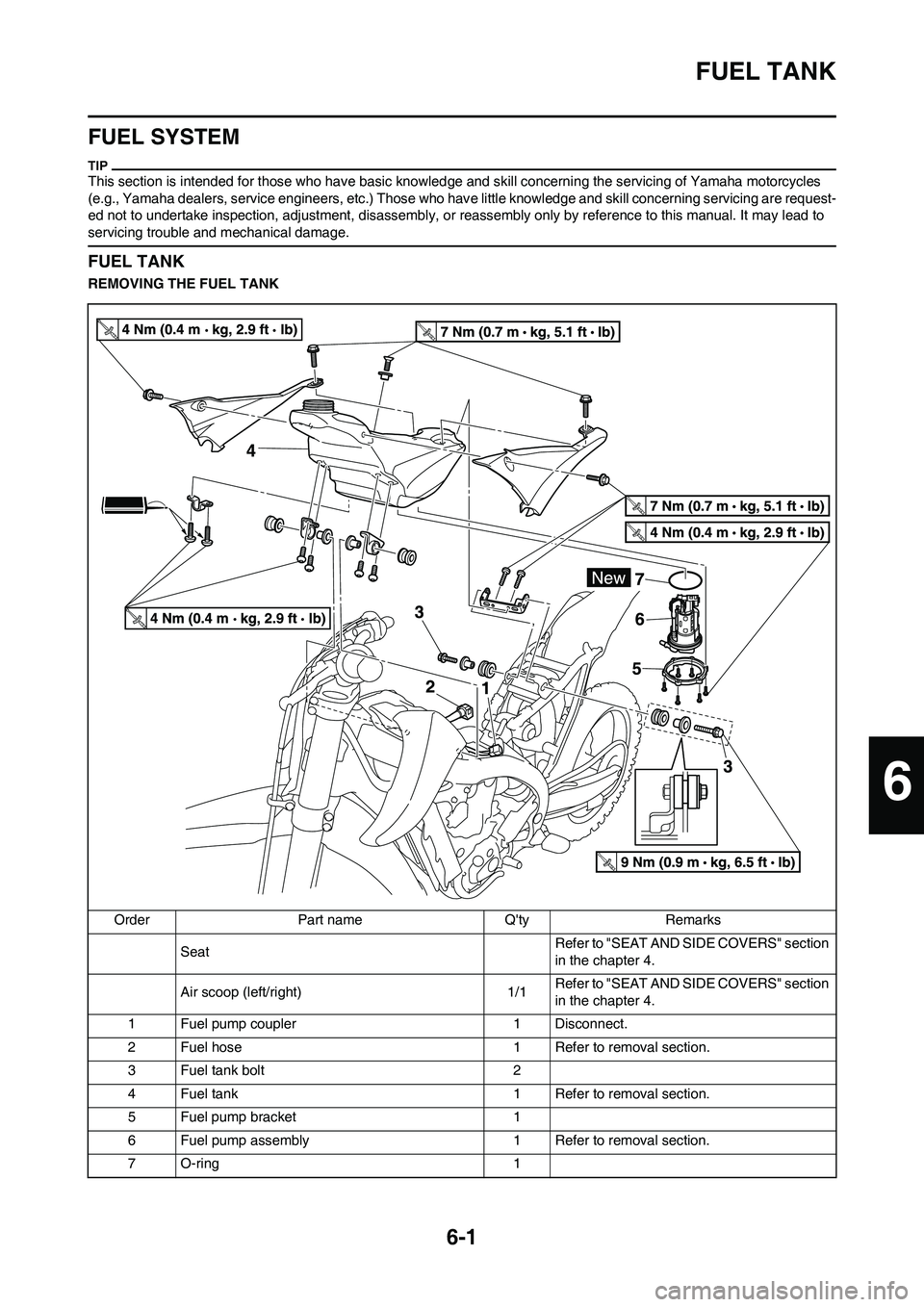
6-1
FUEL TANK
FUEL SYSTEM
This section is intended for those who have basic knowledge and skill concerning the servicing of Yamaha motorcycles
(e.g., Yamaha dealers, service engineers, etc.) Those who have little knowledge and skill concerning servicing are request-
ed not to undertake inspection, adjustment, disassembly, or reassembly only by reference to this manual. It may lead to
servicing trouble and mechanical damage.
FUEL TANK
REMOVING THE FUEL TANK
Order Part name Q'ty Remarks
SeatRefer to "SEAT AND SIDE COVERS" section
in the chapter 4.
Air scoop (left/right) 1/1Refer to "SEAT AND SIDE COVERS" section
in the chapter 4.
1 Fuel pump coupler 1 Disconnect.
2 Fuel hose 1 Refer to removal section.
3 Fuel tank bolt 2
4 Fuel tank 1 Refer to removal section.
5 Fuel pump bracket 1
6 Fuel pump assembly 1 Refer to removal section.
7O-ring 1
6
Page 182 of 230
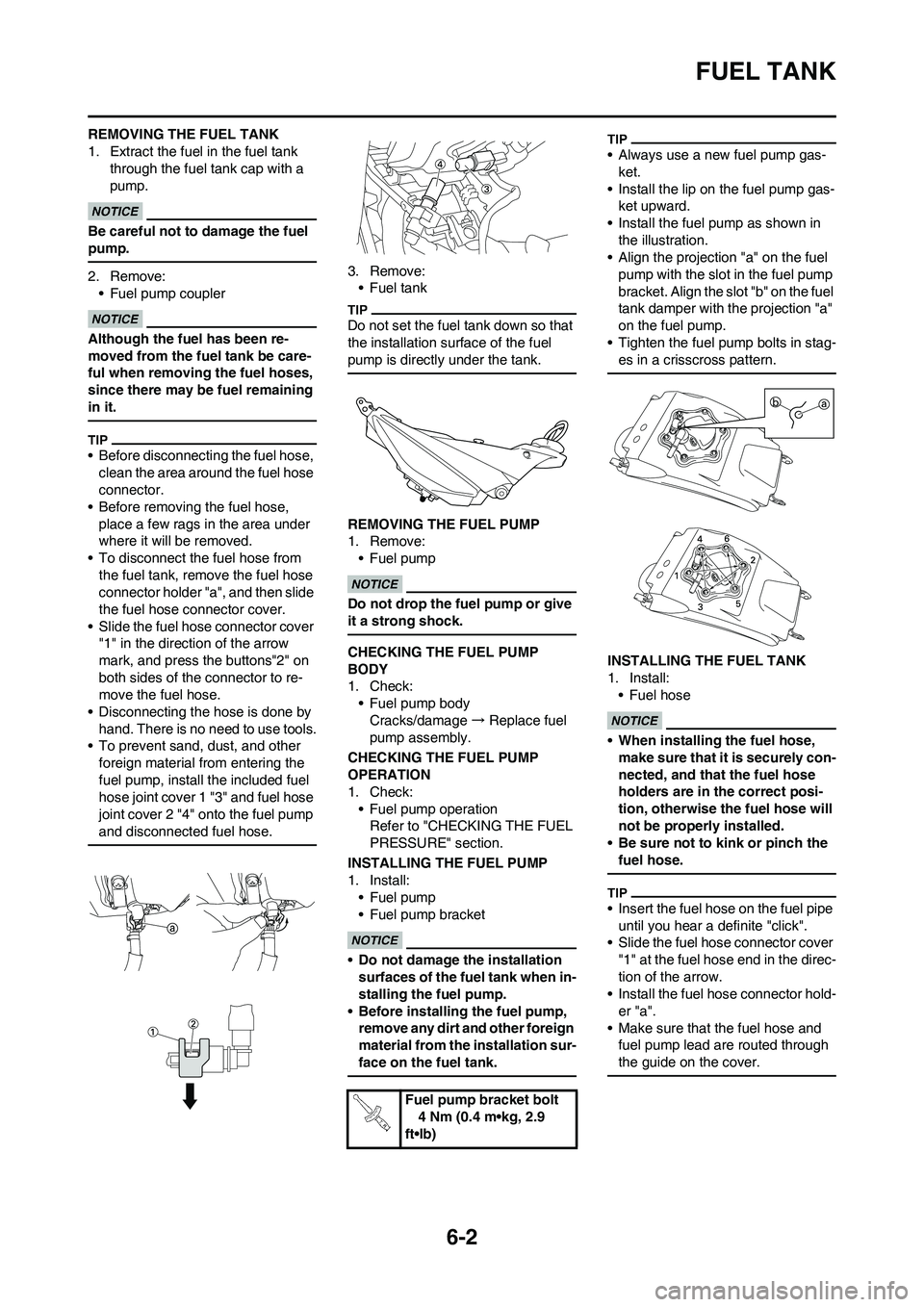
6-2
FUEL TANK
REMOVING THE FUEL TANK
1. Extract the fuel in the fuel tank through the fuel tank cap with a
pump.
Be careful not to damage the fuel
pump.
2. Remove: • Fuel pump coupler
Although the fuel has been re-
moved from the fuel tank be care-
ful when removing the fuel hoses,
since there may be fuel remaining
in it.
• Before disconnecting the fuel hose, clean the area around the fuel hose
connector.
• Before removing the fuel hose, place a few rags in the area under
where it will be removed.
• To disconnect the fuel hose from the fuel tank, remove the fuel hose
connector holder "a", and then slide
the fuel hose connector cover.
• Slide the fuel hose connector cover "1" in the direction of the arrow
mark, and press the buttons"2" on
both sides of the connector to re-
move the fuel hose.
• Disconnecting the hose is done by hand. There is no need to use tools.
• To prevent sand, dust, and other
foreign material from entering the
fuel pump, install the included fuel
hose joint cover 1 "3" and fuel hose
joint cover 2 "4" onto the fuel pump
and disconnected fuel hose.
3. Remove:•Fuel tank
Do not set the fuel tank down so that
the installation surface of the fuel
pump is directly under the tank.
REMOVING THE FUEL PUMP
1. Remove:•Fuel pump
Do not drop the fuel pump or give
it a strong shock.
CHECKING THE FUEL PUMP
BODY
1. Check:
• Fuel pump bodyCracks/damage → Replace fuel
pump assembly.
CHECKING THE FUEL PUMP
OPERATION
1. Check: • Fuel pump operationRefer to "CHECKING THE FUEL
PRESSURE" section.
INSTALLING THE FUEL PUMP
1. Install: •Fuel pump
• Fuel pump bracket
•Do not damage th e installation
surfaces of the fuel tank when in-
stalling the fuel pump.
• Before installing the fuel pump,
remove any dirt and other foreign
material from the installation sur-
face on the fuel tank.
• Always use a new fuel pump gas- ket.
• Install the lip on the fuel pump gas- ket upward.
• Install the fuel pump as shown in
the illustration.
• Align the projection "a" on the fuel pump with the slot in the fuel pump
bracket. Align the slot "b" on the fuel
tank damper with the projection "a"
on the fuel pump.
• Tighten the fuel pump bolts in stag- es in a crisscross pattern.
INSTALLING THE FUEL TANK
1. Install:•Fuel hose
•When installing the fuel hose,
make sure that it is securely con-
nected, and that the fuel hose
holders are in the correct posi-
tion, otherwise the fuel hose will
not be properly installed.
• Be sure not to kink or pinch the
fuel hose.
• Insert the fuel hose on the fuel pipe
until you hear a definite "click".
• Slide the fuel hose connector cover
"1" at the fuel hose end in the direc-
tion of the arrow.
• Install the fuel hose connector hold-
er "a".
• Make sure that the fuel hose and fuel pump lead are routed through
the guide on the cover.
Fuel pump bracket bolt
4 Nm (0.4 m•kg, 2.9
ft•lb)
Page 183 of 230
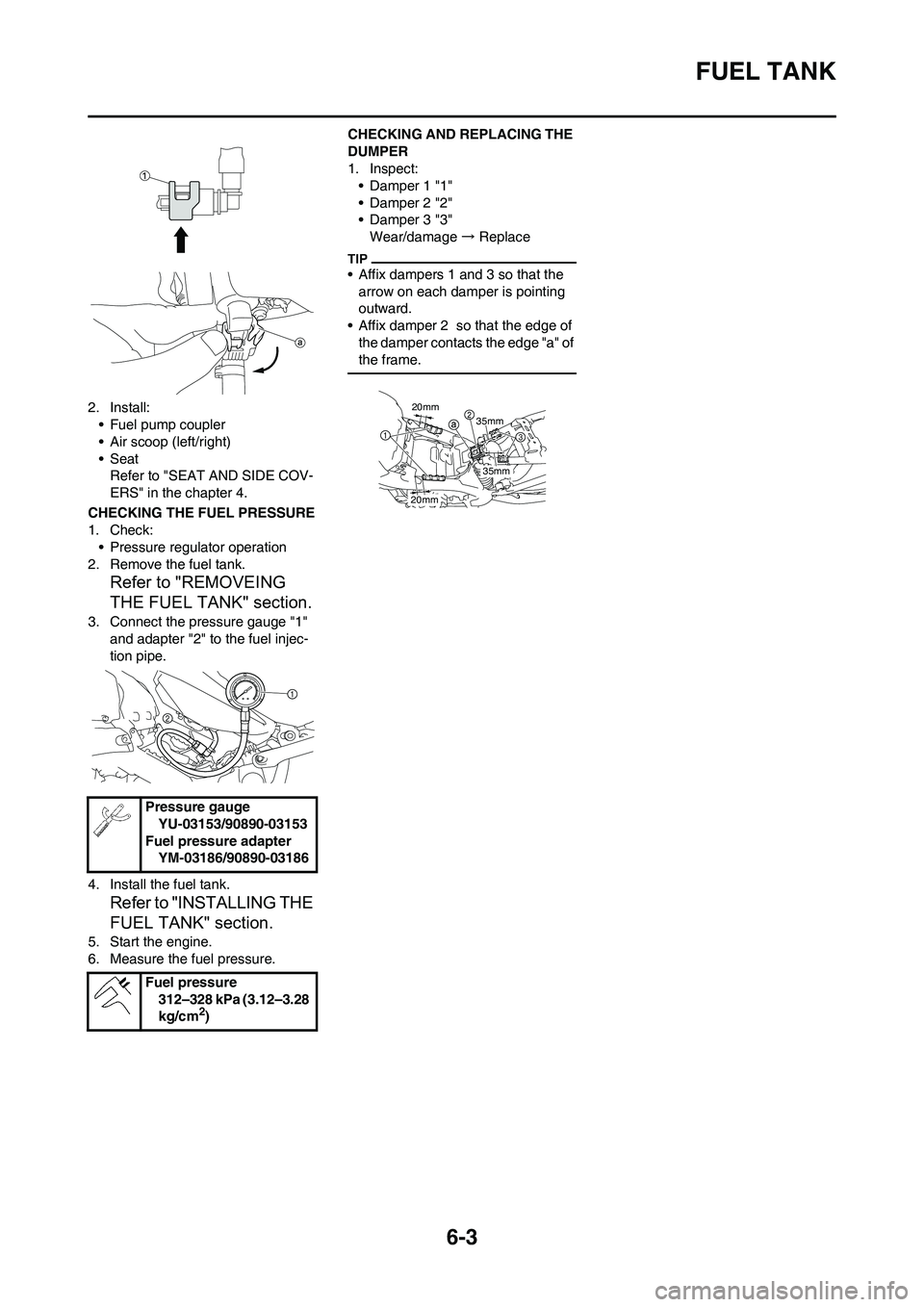
6-3
FUEL TANK
2. Install:
• Fuel pump coupler
• Air scoop (left/right)
• Seat
Refer to "SEAT AND SIDE COV-
ERS" in the chapter 4.
CHECKING THE FUEL PRESSURE
1. Check:
• Pressure regulator operation
2. Remove the fuel tank.
Refer to "REMOVEING
THE FUEL TANK" section.
3. Connect the pressure gauge "1"
and adapter "2" to the fuel injec-
tion pipe.
4. Install the fuel tank.
Refer to "INSTALLING THE
FUEL TANK" section.
5. Start the engine.
6. Measure the fuel pressure.CHECKING AND REPLACING THE
DUMPER
1. Inspect:
• Damper 1 "1"
• Damper 2 "2"
• Damper 3 "3"
Wear/damage → Replace
• Affix dampers 1 and 3 so that the
arrow on each damper is pointing
outward.
• Affix damper 2 so that the edge of
the damper contacts the edge "a" of
the frame.
Pressure gauge
YU-03153/90890-03153
Fuel pressure adapter
YM-03186/90890-03186
Fuel pressure
312–328 kPa (3.12–3.28
kg/cm
2)
20mm
20mm
35mm 35mm
Page 184 of 230
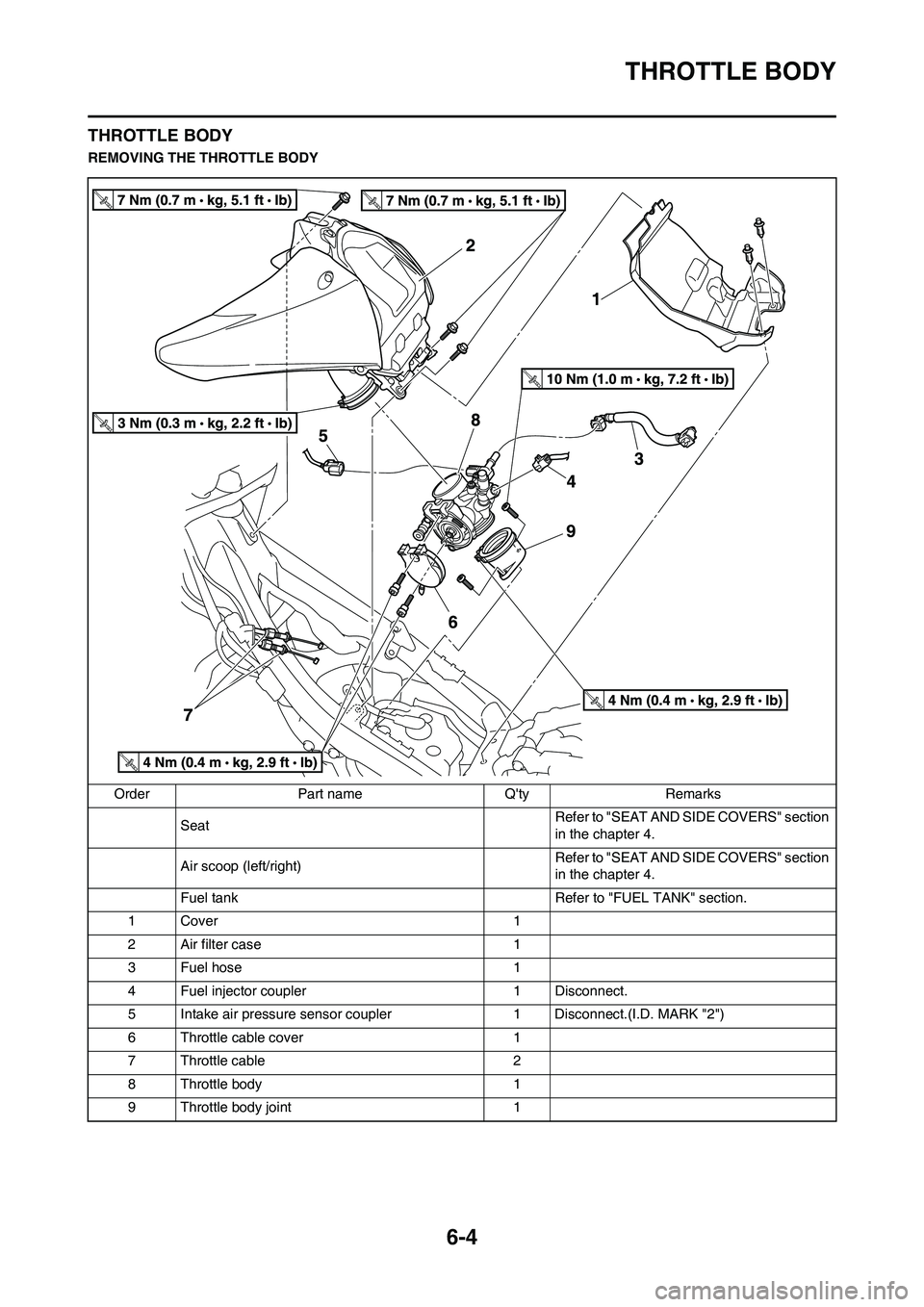
6-4
THROTTLE BODY
THROTTLE BODY
REMOVING THE THROTTLE BODY
Order Part name Q'ty Remarks
SeatRefer to "SEAT AND SIDE COVERS" section
in the chapter 4.
Air scoop (left/right)Refer to "SEAT AND SIDE COVERS" section
in the chapter 4.
Fuel tank Refer to "FUEL TANK" section.
1 Cover 1
2 Air filter case 1
3 Fuel hose 1
4 Fuel injector coupler 1 Disconnect.
5 Intake air pressure sensor coupler 1 Disconnect.(I.D. MARK "2")
6 Throttle cable cover 1
7 Throttle cable 2
8 Throttle body 1
9 Throttle body joint 1
Page 185 of 230
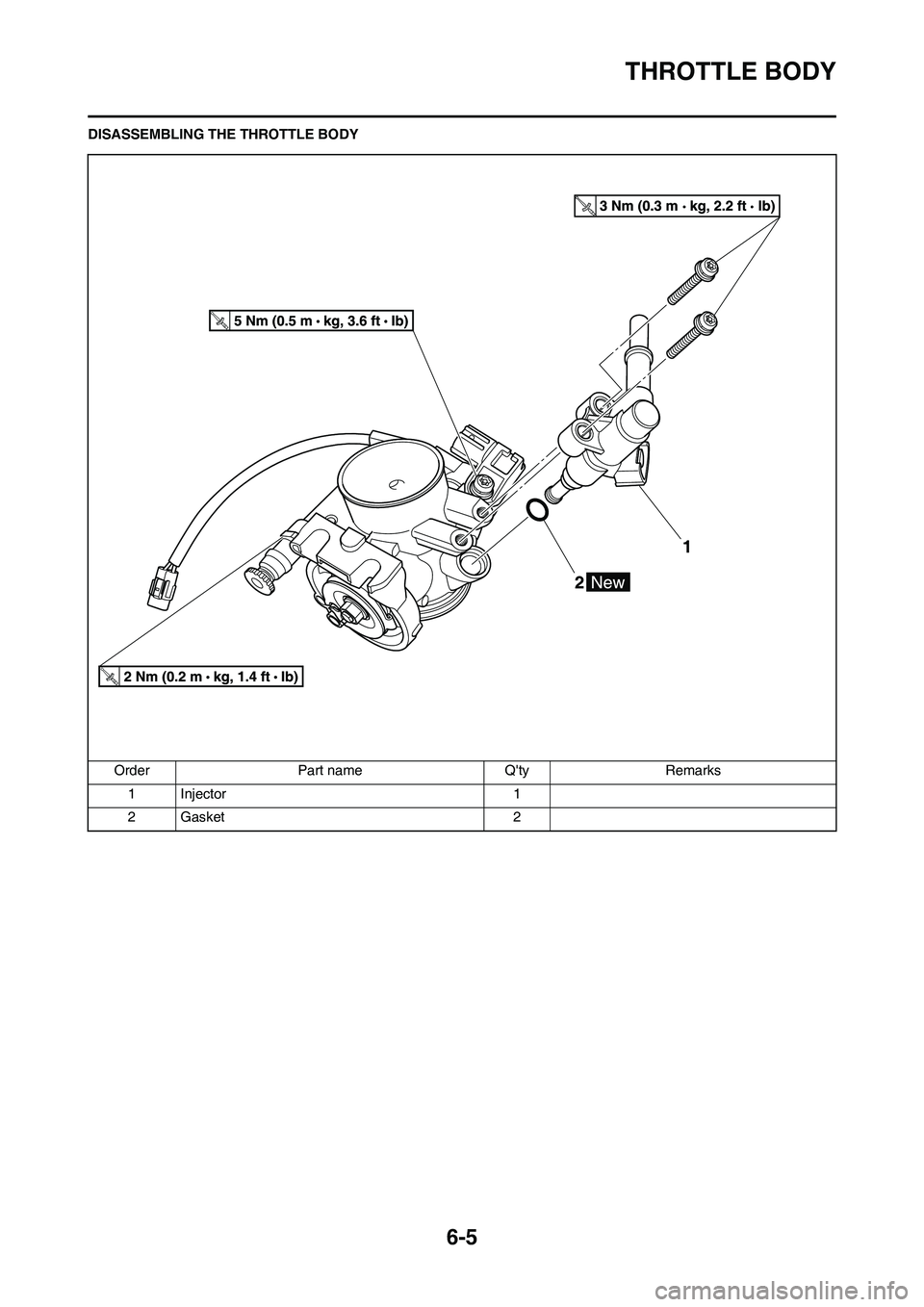
6-5
THROTTLE BODY
DISASSEMBLING THE THROTTLE BODY
Order Part name Q'ty Remarks
1Injector 1
2 Gasket 2
Page 186 of 230
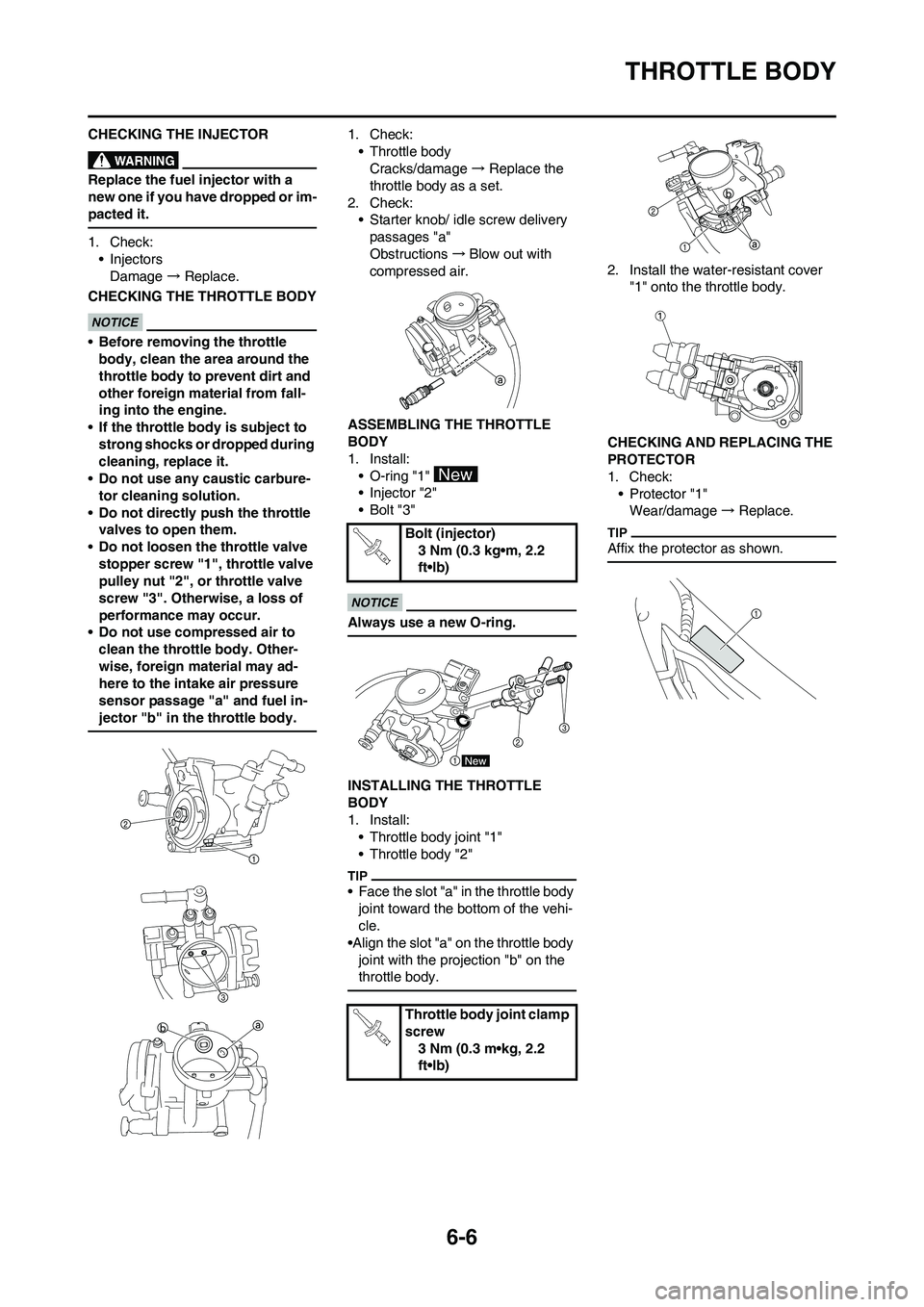
6-6
THROTTLE BODY
CHECKING THE INJECTOR
Replace the fuel injector with a
new one if you have dropped or im-
pacted it.
1. Check:
• Injectors
Damage → Replace.
CHECKING THE THROTTLE BODY
•Before removing the throttle
body, clean the area around the
throttle body to prevent dirt and
other foreign material from fall-
ing into the engine.
•If the throttle body is subject to
strong shocks or dropped during
cleaning, replace it.
•Do not use any caustic carbure-
tor cleaning solution.
•Do not directly push the throttle
valves to open them.
•Do not loosen the throttle valve
stopper screw "1", throttle valve
pulley nut "2", or throttle valve
screw "3". Otherwise, a loss of
performance may occur.
•Do not use compressed air to
clean the throttle body. Other-
wise, foreign material may ad-
here to the intake air pressure
sensor passage "a" and fuel in-
jector "b" in the throttle body.
1. Check:
• Throttle body
Cracks/damage → Replace the
throttle body as a set.
2. Check:
• Starter knob/ idle screw delivery
passages "a"
Obstructions →Blow out with
compressed air.
ASSEMBLING THE THROTTLE
BODY
1. Install:
• O-ring "1"
• Injector "2"
•Bolt "3"
Always use a new O-ring.
INSTALLING THE THROTTLE
BODY
1. Install:
• Throttle body joint "1"
• Throttle body "2"
• Face the slot "a" in the throttle body
joint toward the bottom of the vehi-
cle.
•Align the slot "a" on the throttle body
joint with the projection "b" on the
throttle body.
2. Install the water-resistant cover
"1" onto the throttle body.
CHECKING AND REPLACING THE
PROTECTOR
1. Check:
• Protector "1"
Wear/damage → Replace.
Affix the protector as shown.Bolt (injector)
3 Nm (0.3 kg•m, 2.2
ft•lb)
Throttle body joint clamp
screw
3 Nm (0.3 m•kg, 2.2
ft•lb)
Page 187 of 230
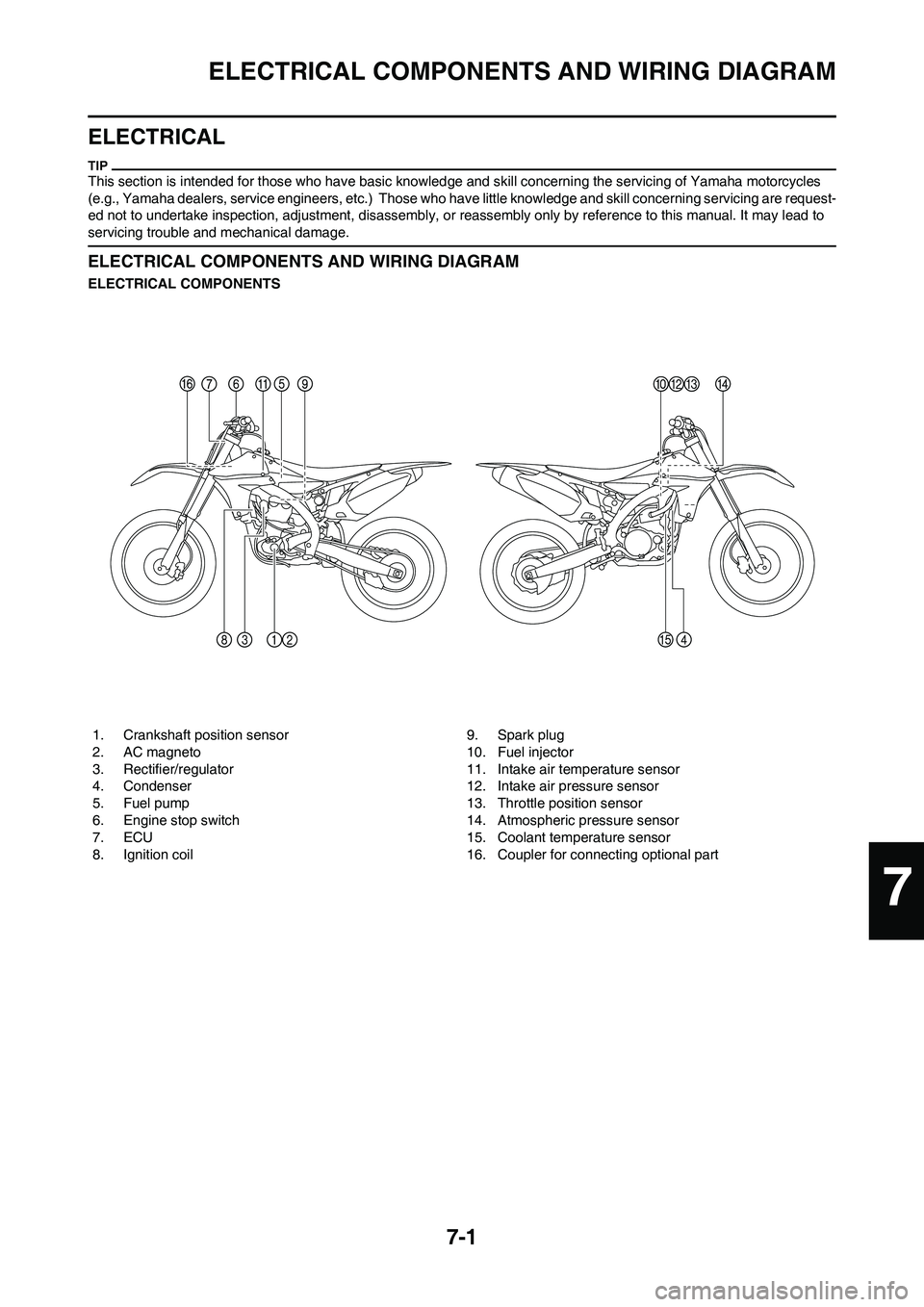
7-1
ELECTRICAL COMPONENTS AND WIRING DIAGRAM
ELECTRICAL
This section is intended for those who have basic knowledge and skill concerning the servicing of Yamaha motorcycles
(e.g., Yamaha dealers, service engineers, etc.) Those who have little knowledge and skill concerning servicing are request-
ed not to undertake inspection, adjustment, disassembly, or reassembly only by reference to this manual. It may lead to
servicing trouble and mechanical damage.
ELECTRICAL COMPONENTS AND WIRING DIAGRAM
ELECTRICAL COMPONENTS
1. Crankshaft position sensor
2. AC magneto
3. Rectifier/regulator
4. Condenser
5. Fuel pump
6. Engine stop switch
7. ECU
8. Ignition coil9. Spark plug
10. Fuel injector
11. Intake air temperature sensor
12. Intake air pressure sensor
13. Throttle position sensor
14. Atmospheric pressure sensor
15. Coolant temperature sensor
16. Coupler for connecting optional part
7
Page 188 of 230
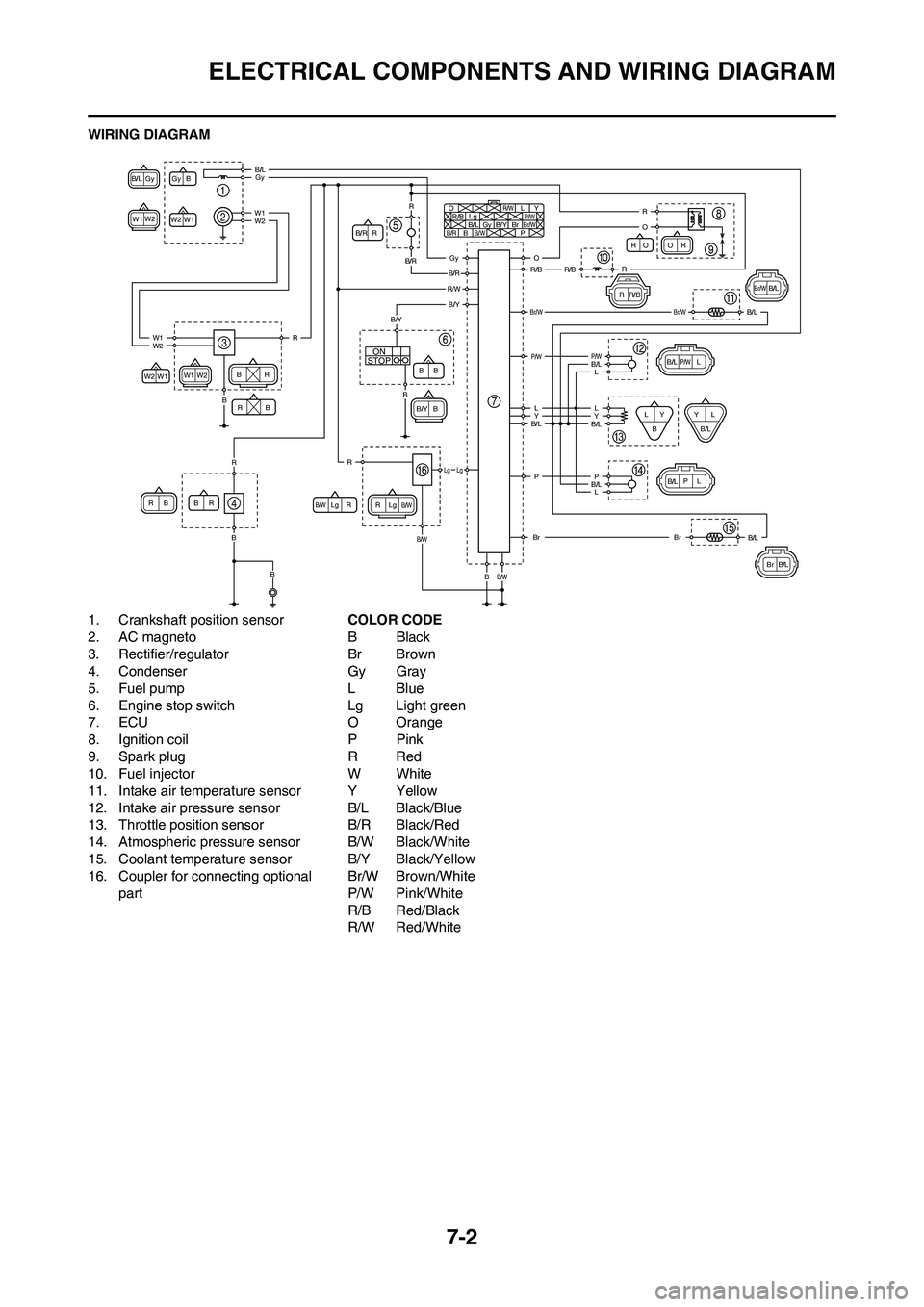
7-2
ELECTRICAL COMPONENTS AND WIRING DIAGRAM
WIRING DIAGRAM
1. Crankshaft position sensor
2. AC magneto
3. Rectifier/regulator
4. Condenser
5. Fuel pump
6. Engine stop switch
7. ECU
8. Ignition coil
9. Spark plug
10. Fuel injector
11. Intake air temperature sensor
12. Intake air pressure sensor
13. Throttle position sensor
14. Atmospheric pressure sensor
15. Coolant temperature sensor
16. Coupler for connecting optional part COLOR CODE
BBlack
Br Brown
Gy Gray
LBlue
Lg Light green
O Orange
PPink
RRed
WWhite
YYellow
B/L Black/Blue
B/R Black/Red
B/W Black/White
B/Y Black/Yellow
Br/W Brown/White
P/W Pink/White
R/B Red/Black
R/W Red/White
STOPON
Gy
Gy
B
B
/L
W1
W2
W2 O
R /B
R RR
R
R
R R
Lg
Lg Lg L
P
/W
P YB
/RB
B B
B
B BB
BB/W
B /W
B/W Br
/WGy
B /L
W1 W1
W2 W2 B
/Y
B /Y Br
B /R
R /W
OO
R /B
RR
R
L
P/W
P YL
L
LY
Br /WB /L
B /L
B/L
B
B/L
B/L
Br
W1
Br
/W
W2
R
R O
B/L
L
Y
B /L
Br
R
P
Gy
Gy
B /R
B
/R
R/WB /Y
B
/L
W1
W2
W1 R
R R
B
B
/Y
Lg Lg
O
R /B
R/B
Br /W
P /W P
/W
L L
Y
B /L B
/L
B/L
Br
B
B /W
B
/W
B
B
B L
B
/L
P
Page 189 of 230
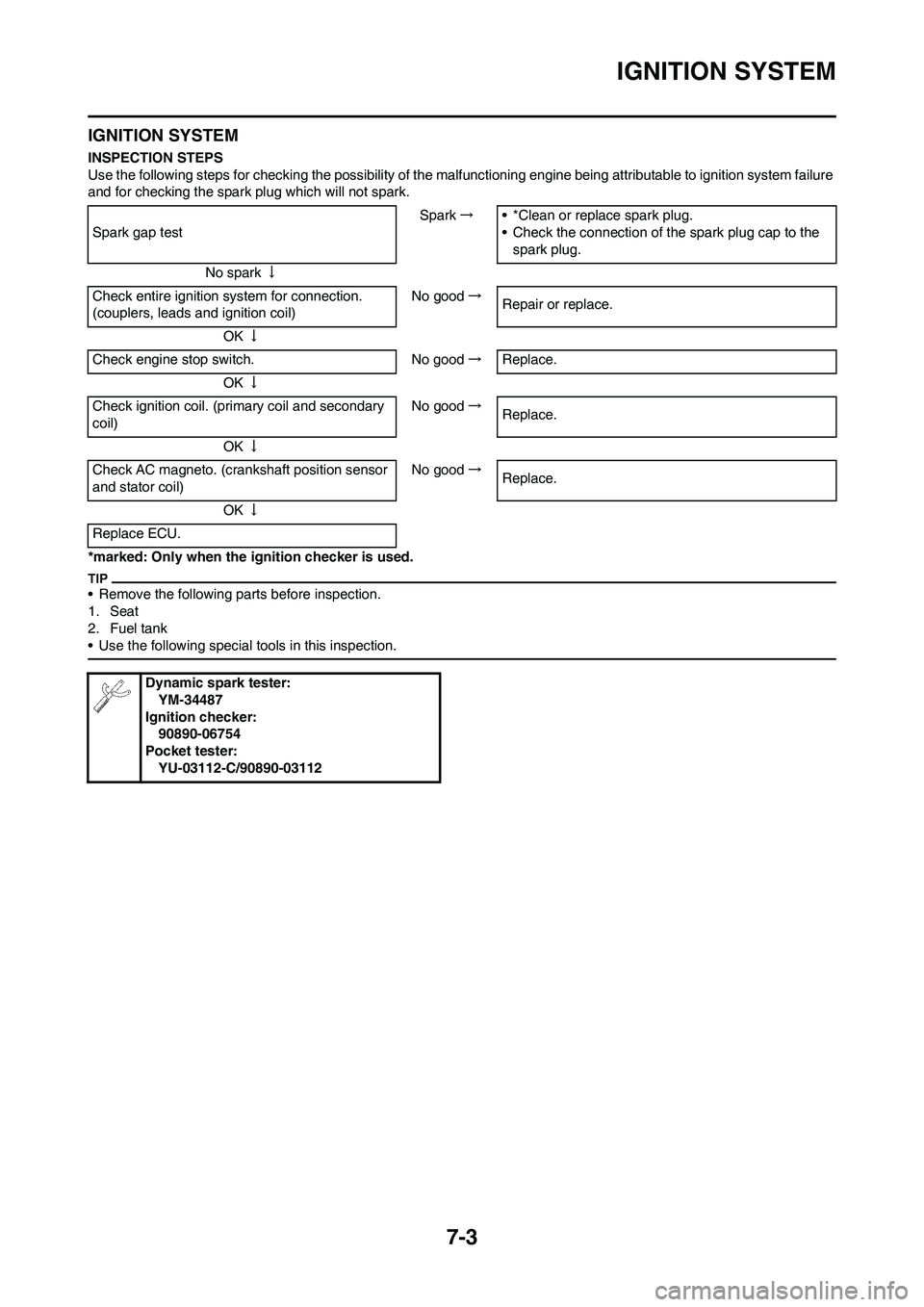
7-3
IGNITION SYSTEM
IGNITION SYSTEM
INSPECTION STEPS
Use the following steps for checking the possibility of the malfunctioning engine being attributable to ignition system failure
and for checking the spark plug which will not spark.
*marked: Only when the ignition checker is used.
• Remove the following parts before inspection.
1. Seat
2. Fuel tank
• Use the following special tools in this inspection.
Spark gap testSpark→• *Clean or replace spark plug.
• Check the connection of the spark plug cap to the
spark plug.
No spark↓
Check entire ignition system for connection.
(couplers, leads and ignition coil)No good→
Repair or replace.
OK↓
Check engine stop switch. No good→Replace.
OK↓
Check ignition coil. (primary coil and secondary
coil)No good→
Replace.
OK↓
Check AC magneto. (crankshaft position sensor
and stator coil)No good→
Replace.
OK↓
Replace ECU.
Dynamic spark tester:
YM-34487
Ignition checker:
90890-06754
Pocket tester:
YU-03112-C/90890-03112
Page 190 of 230
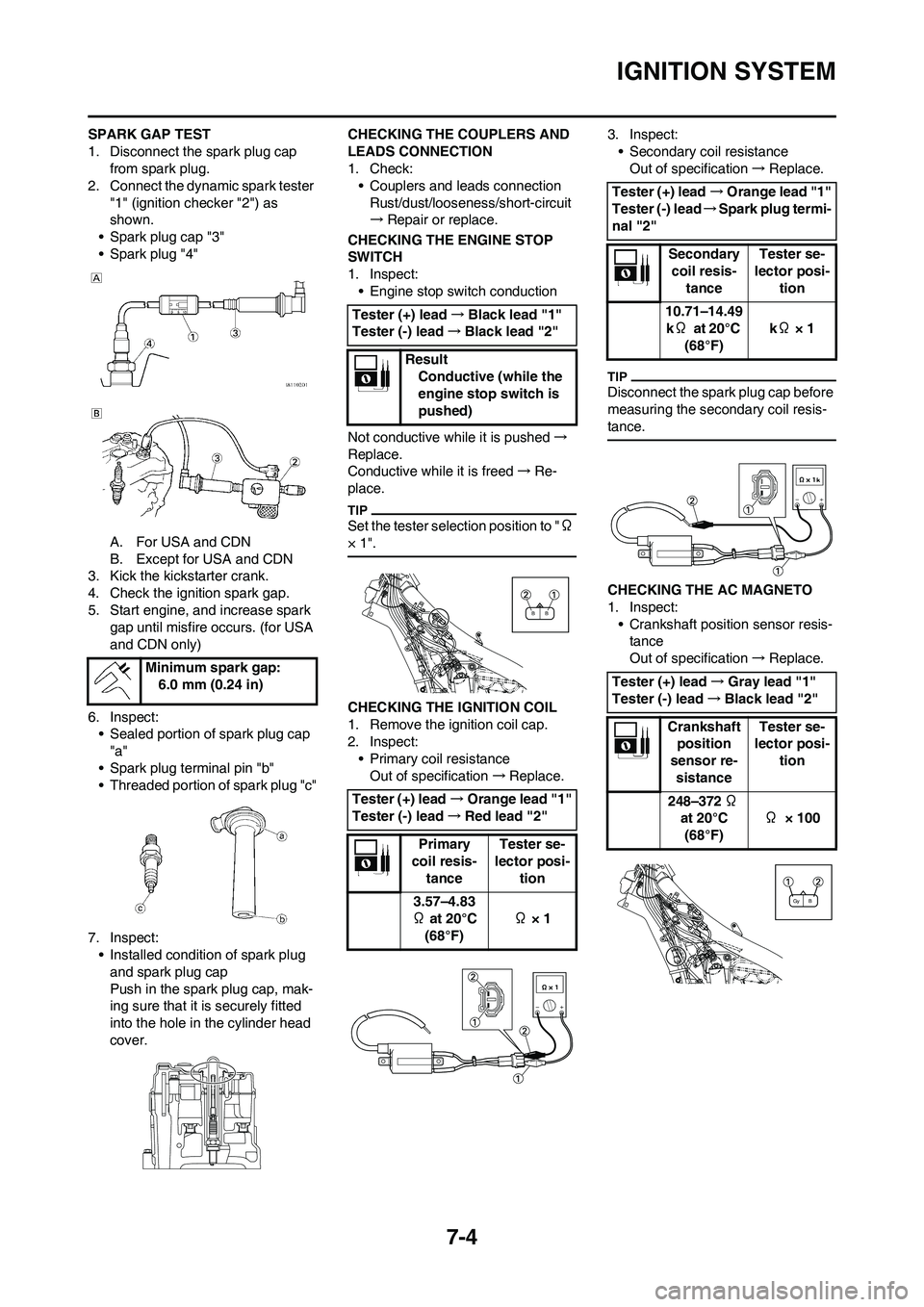
7-4
IGNITION SYSTEM
SPARK GAP TEST
1. Disconnect the spark plug cap
from spark plug.
2. Connect the dynamic spark tester
"1" (ignition checker "2") as
shown.
• Spark plug cap "3"
• Spark plug "4"
A. For USA and CDN
B. Except for USA and CDN
3. Kick the kickstarter crank.
4. Check the ignition spark gap.
5. Start engine, and increase spark
gap until misfire occurs. (for USA
and CDN only)
6. Inspect:
• Sealed portion of spark plug cap
"a"
• Spark plug terminal pin "b"
• Threaded portion of spark plug "c"
7. Inspect:
• Installed condition of spark plug
and spark plug cap
Push in the spark plug cap, mak-
ing sure that it is securely fitted
into the hole in the cylinder head
cover.CHECKING THE COUPLERS AND
LEADS CONNECTION
1. Check:
• Couplers and leads connection
Rust/dust/looseness/short-circuit
→Repair or replace.
CHECKING THE ENGINE STOP
SWITCH
1. Inspect:
• Engine stop switch conduction
Not conductive while it is pushed→
Replace.
Conductive while it is freed→Re-
place.
Set the tester selection position to "Ω
× 1".
CHECKING THE IGNITION COIL
1. Remove the ignition coil cap.
2. Inspect:
• Primary coil resistance
Out of specification→Replace.3. Inspect:
• Secondary coil resistance
Out of specification→Replace.
Disconnect the spark plug cap before
measuring the secondary coil resis-
tance.
CHECKING THE AC MAGNETO
1. Inspect:
• Crankshaft position sensor resis-
tance
Out of specification→Replace.
Minimum spark gap:
6.0 mm (0.24 in)
Tester (+) lead→Black lead "1"
Tester (-) lead→Black lead "2"
Result
Conductive (while the
engine stop switch is
pushed)
Tester (+) lead→Orange lead "1"
Tester (-) lead→Red lead "2"
Primary
coil resis-
tanceTester se-
lector posi-
tion
3.57–4.83
Ω at 20°C
(68°F) Ω × 1
BB
Tester (+) lead→Orange lead "1"
Tester (-) lead→Spark plug termi-
nal "2"
Secondary
coil resis-
tanceTester se-
lector posi-
tion
10.71–14.49
kΩ at 20°C
(68°F) kΩ × 1
Tester (+) lead→Gray lead "1"
Tester (-) lead→Black lead "2"
Crankshaft
position
sensor re-
sistanceTester se-
lector posi-
tion
248–372 Ω
at 20°C
(68°F)Ω × 100
GyB